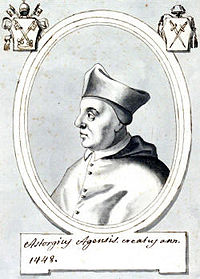|
Astorgio Agnensi
 Astorgio Agnensi (1391–1451) was an Italian Roman Catholic bishop and cardinal, multiple papal governor and multiple Curiate official. BiographyAstorgio Agnensi was born in Naples in 1391.[1] He was elected Bishop of Mileto on 18 September 1411.[1] He was transferred to the see of Ravello on 15 February 1413; to the see of Melfi on 25 January 1418; and then to the see of Ancona on 6 March 1419.[1] On 22 August 1422 he was transferred to the see of Ascoli Piceno but refused; then, on 19 October that year, the see of Umana was united with that of Ancona.[1][2] Agnensi then moved to Rome, becoming apostolic treasurer.[1] From August 1426 to April 1427, he was the papal governor of the Duchy of Spoleto and the March of Ancona.[1] He and Barthélémy Texier, Master of the Order of Preachers, were sent to the see of Iesi to deal with the heretics of the Fraticelli. [1] On 8 February 1436 he was promoted to the see of Benevento; he occupied this position until his death.[1] On 26 March 1442 Pope Eugene IV named him his vicar in spiritualibus and governor of Rome, a post he held until 1447.[1] He was also the apostolic administrator of the see of Canna from 16 June 1445 until 25 May 1449.[1] In September 1447, he became papal governor of Bologna.[1] He was Vice-Chancellor of the Holy Roman Church during the papacy of Eugene IV.[1] Pope Nicholas V made him a cardinal in the consistory of 20 December 1448.[1] He received the titular church of Sant'Eusebio on 3 January 1449, and the red hat on 6 January 1449.[1] He was Camerlengo of the Sacred College of Cardinals from 27 October 1449 until 1450.[1] He died in Rome on 10 October 1451.[1] He is buried in the cloister of Santa Maria sopra Minerva.[1] References
External links
|